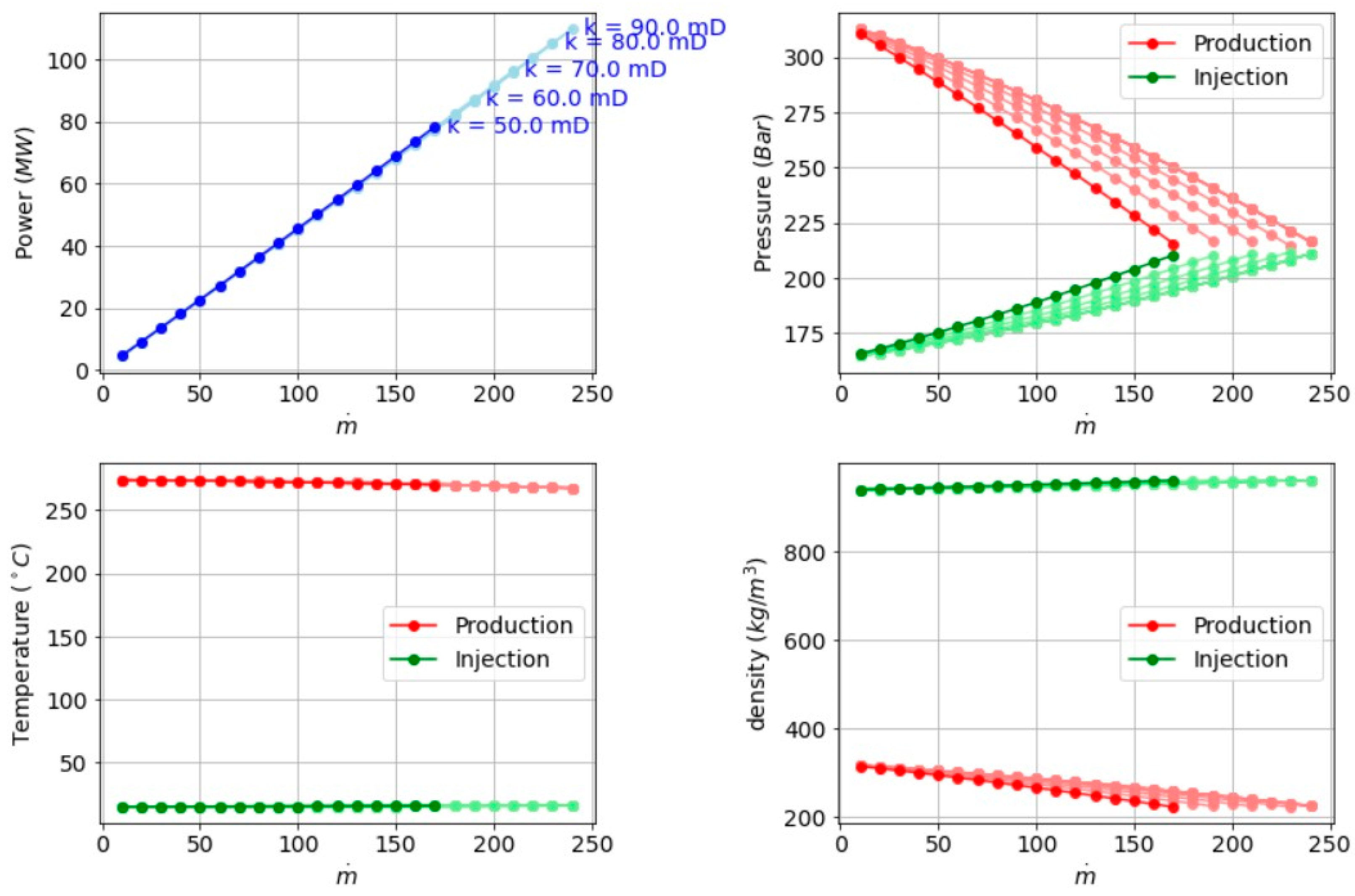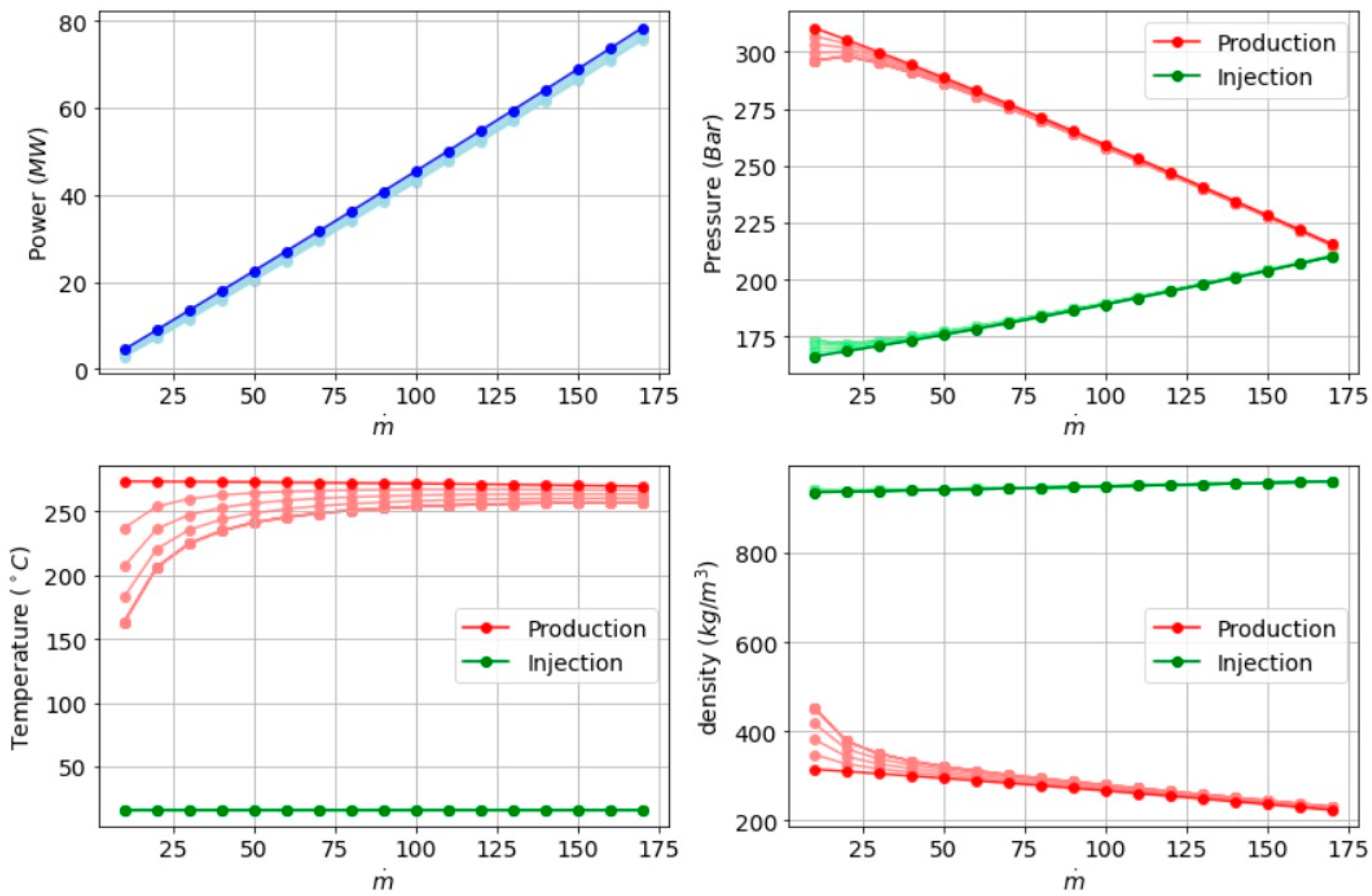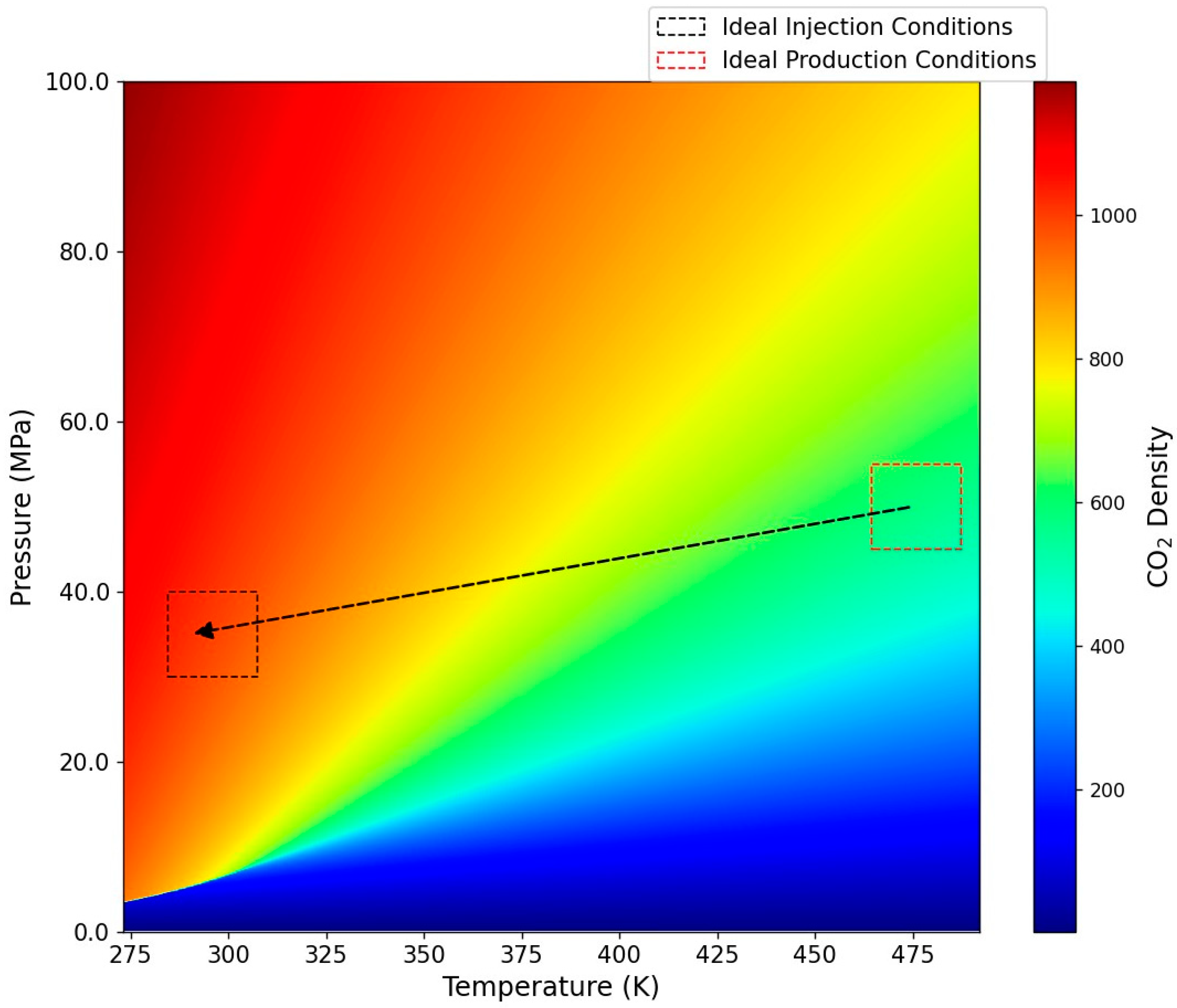Sensitivity of CO2 Flow in Production/Injection Wells in CPG (CO2 Plume Geothermal) Systems †
Abstract
1. Introduction
2. System Description
2.1. The System
2.2. Inflow Performance
2.3. Wellbore Flow
3. Sensitivity Analysis
4. Results/Discussion
- Power (top-left): The net power output at the surface.
- Pressure (top-right): The injection and production wellhead pressures.
- Temperature (bottom-left): The injection and production wellhead temperatures.
- Density (bottom-right): The injection and production wellhead fluid densities. These variables provide insight into how operating conditions (e.g., flow rate) and reservoir properties affect thermodynamic behavior and overall system performance.
4.1. Sensitivity to Injection Temperature
- Power vs. Mass Flow: Higher injection temperature diminishes the available temperature (and thus density) contrast between injected and produced fluid. Consequently, the thermosiphon effect weakens, and both the achievable flow rate and resulting power can be lower. The drop in maximum power is about 10% per temperature step in these simulations.
- Wellhead Pressures: As the injection fluid warms, its density drops. The injection wellhead pressure must increase to maintain the same flow rate. This more rapid rise in injection pressure reduces the pressure differential driving flow, limiting the upper bound of ṁ.
- Wellhead Temperatures: The production temperature remains fairly constant at the reservoir’s high temperature (around 250 °C), but the injection temperature steps (16, 24, 33, 42, 51 °C) appear distinctly in the bottom-left plot. This widening gap in the 178 temperature lines reveals the increasing mismatch in thermodynamic conditions that 179 hamper the natural circulation.
- Densities: Each injection temperature increment causes a reduction of about 20 kg/m3 in injection fluid density at the wellhead. Since buoyancy (driven by the density difference) is critical to the thermosiphon effect, these density shifts significantly curtail the maximum possible flow rate.

4.2. Permeability
- Power vs. Mass Flow: As permeability increases, the system can sustain higher flow rates before reaching a pressure limit. This allows the linear portion of the power-vs.- mass-flow curve to extend further to the right, increasing the maximum achievable power.
- Pressures at Production and Injection Wells: With higher permeability, the production wellhead pressure decreases more slowly (or from a higher baseline), and the injection wellhead pressure grows more gradually. This indicates lower flow resistance through the reservoir and delayed convergence between injection and production pressures.
- Temperatures: Wellhead temperatures do not change drastically with permeability, because the reservoir heat source remains effectively the same. However, at very high flow rates, higher permeability can permit slightly faster fluid cycling, potentially leading to marginally lower production temperature if residence times in the reservoir drop.
- Densities: Production fluid density generally follows the trend of decreasing with increased flow (due to increased production temperature and expansion). Injection fluid density remains relatively stable but may shift slightly as wellhead pressure changes. Higher permeability primarily manifests as pressure differences rather than large shifts in wellhead temperatures or densities.

4.3. Adiabatic Hypothesis
- Temperature Drop at Low Flow: When ṁ is small, fluid velocity through the wellbore is low, allowing more time for heat exchange with surrounding formations. As a result, the production fluid temperature can drop significantly before reaching the surface, leading to a higher fluid density and reduced buoyant driving force.
- Mitigation at High Flow: At higher ṁ, the fluid transits the wellbore more rapidly, reducing heat losses. This preserves a larger fraction of the fluid’s thermal energy and density contrast, mitigating the detrimental effect on thermosiphon circulation.
- Implications for Power Output: Excessive heat losses in the wellbore can weaken or even disrupt the naturally driven flow, particularly at lower mass flow rates. In practical systems, wellbore insulation (or maintaining higher injection temperature) may be essential to minimize these losses and maintain robust power output.

4.4. Overall Observations and Practical Insights
- Reservoir Permeability: Choosing formations of sufficient permeability to handle desired flow rates without excessive pressure buildup.
- Injection Temperature and Wellbore Insulation: Preserving a strong temperature (and density) difference to maximize thermosiphon-driven flow.
- Operational Flow Rates: Avoiding very low flow rates that amplify wellbore heat losses and degrade the thermosiphon effect.
5. Conclusions
Author Contributions
Funding
Institutional Review Board Statement
Informed Consent Statement
Data Availability Statement
Conflicts of Interest
References
- DiPippo, R. Geothermal Power Plants: Principles, Applications, Case Studies and Environmental Impact; Butterworth-Heinemann: Oxford, UK, 2012. [Google Scholar]
- Breede, K.; Dzebisashvili, K.; Liu, X.; Falcone, G. A systematic review of enhanced (or engineered) geothermal systems: Past, present and future. Geotherm. Energy 2013, 1, 4. [Google Scholar] [CrossRef]
- Brown, D.W. A hot dry rock geothermal energy concept utilizing supercritical CO2 instead of water. In Proceedings of the Twenty-Fifth Workshop on Geothermal Reservoir Engineering, Stanford University, Stanford, CA, USA, 24–26 January 2000; pp. 233–238. [Google Scholar]
- Adams, B.M.; Kuehn, T.H.; Bielicki, J.M.; Randolph, J.B.; Saar, M.O. A comparison of electric power output of CO2 Plume Geothermal (CPG) and brine geothermal systems for varying reservoir conditions. Appl. Energy 2015, 140, 365–377. [Google Scholar] [CrossRef]
- Langenfeld, J.K.; Bielicki, J.M. Assessment of sites for CO2 storage and CO2 capture, utilization, and storage systems in geothermal reservoirs. Energy Procedia 2017, 114, 7009–7017. [Google Scholar] [CrossRef]
- Freifeld, B.; Zakim, S.; Pan, L.; Cutright, B.; Sheu, M.; Doughty, C.; Held, T. Geothermal energy production coupled with CCS: A field demonstration at the SECARB Cranfield Site, Cranfield, Mississippi, USA. Energy Procedia 2013, 37, 6595–6603. [Google Scholar] [CrossRef]
- Global CCS Institute. Global CCS Institute 2022 Status Report. 2022. Available online: https://status22.globalccsinstitute.com/2022-status-report/introduction/ (accessed on 1 July 2023).
- Lau, H.C.; Ramakrishna, S.; Zhang, K.; Radhamani, A.V. The role of carbon capture and storage in the energy transition. Energy Fuels 2021, 35, 7364–7386. [Google Scholar] [CrossRef]
- Adams, B.M.; Kuehn, T.H.; Bielicki, J.M.; Randolph, J.B.; Saar, M.O. On the importance of the thermosiphon effect in CPG (CO2 plume geothermal) power systems. Energy 2014, 69, 409–418. [Google Scholar] [CrossRef]
- Gravanis, E.; Sarris, E. A working model for estimating CO2-induced uplift of cap rocks under different flow regimes in CO2 sequestration. Geomech. Energy Environ. 2023, 33, 100433. [Google Scholar] [CrossRef]
- Sarris, E.; Gravanis, E. Flow regime analysis of the pressure build-up during CO2 injection in saturated porous rock formations. Energies 2019, 12, 2972. [Google Scholar] [CrossRef]
- Ernestos, S.; Elias, G.; Panos, P. Investigation of self-similar interface evolution in carbon dioxide sequestration in saline aquifers. Transp. Porous Media 2014, 103, 341–359. [Google Scholar] [CrossRef]
- Kovscek, A.R. Screening criteria for CO2 storage in oil reservoirs. Pet. Sci. Technol. 2002, 20, 841–866. [Google Scholar] [CrossRef]
- Leaver, J.D. Injectivity and Productivity Estimation in Multiple Feed Geothermal Wells; Technical report; Department of Petroleum Engineering, Stanford University: Stanford, CA, USA; Ministry of Works: Auckland, New Zealand, 1986. [Google Scholar]
- Guo, B. Well Productivity Handbook: Vertical, Fractured, Horizontal, Multilateral, Multi-Fractured, and Radial-Fractured Wells; Gulf Professional Publishing: Cambridge, MA, USA, 2019. [Google Scholar]
- Ahmed, T. Reservoir Engineering Handbook; Gulf Professional Publishing: Cambridge, MA, USA, 2018. [Google Scholar]
- Guðmundsdóttir, H. A coupled wellbore-reservoir simulator utilizing measured wellhead conditions. Master’s Thesis, University of Iceland, Reykjavík, Iceland, October 2012. [Google Scholar]
- Bell, I.H.; Wronski, J.; Quoilin, S.; Lemort, V. Pure and Pseudo-pure Fluid Thermophysical Property Evaluation and the Open-Source Thermophysical Property Library CoolProp. Ind. Eng. Chem. Res. 2014, 53, 2498–2508. [Google Scholar] [CrossRef] [PubMed]

| Parameter | Value | Units (SI) |
|---|---|---|
| Pressure (Pe) | 4 × 107 | Pa |
| Temperature (T) | 573.15 | K |
| Depth | 2.5 × 103 | m |
| permeability (k) | 5 × 10−14 | m2 |
| thickness (h) | 50 | m |
| viscosity (µ) | 5.5 × 10−5 | Pa s |
| Formation radius (re) | 1000 | m |
| Well radius (rw) | 0.1 | m |
| Injectivity/Productivity (I) | 4 × 10−8 | m3/s/Pa |
Disclaimer/Publisher’s Note: The statements, opinions and data contained in all publications are solely those of the individual author(s) and contributor(s) and not of MDPI and/or the editor(s). MDPI and/or the editor(s) disclaim responsibility for any injury to people or property resulting from any ideas, methods, instructions or products referred to in the content. |
© 2025 by the authors. Licensee MDPI, Basel, Switzerland. This article is an open access article distributed under the terms and conditions of the Creative Commons Attribution (CC BY) license (https://creativecommons.org/licenses/by/4.0/).
Share and Cite
Fotias, S.P.; Gaganis, V. Sensitivity of CO2 Flow in Production/Injection Wells in CPG (CO2 Plume Geothermal) Systems. Mater. Proc. 2023, 15, 95. https://doi.org/10.3390/materproc2023015095
Fotias SP, Gaganis V. Sensitivity of CO2 Flow in Production/Injection Wells in CPG (CO2 Plume Geothermal) Systems. Materials Proceedings. 2023; 15(1):95. https://doi.org/10.3390/materproc2023015095
Chicago/Turabian StyleFotias, Sofianos Panagiotis, and Vassilis Gaganis. 2023. "Sensitivity of CO2 Flow in Production/Injection Wells in CPG (CO2 Plume Geothermal) Systems" Materials Proceedings 15, no. 1: 95. https://doi.org/10.3390/materproc2023015095
APA StyleFotias, S. P., & Gaganis, V. (2023). Sensitivity of CO2 Flow in Production/Injection Wells in CPG (CO2 Plume Geothermal) Systems. Materials Proceedings, 15(1), 95. https://doi.org/10.3390/materproc2023015095






